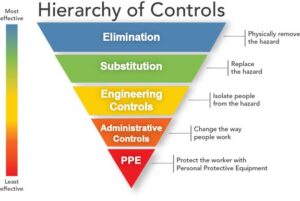September
The Hierarchy of Ergonomics Controls
Safety experts are familiar with the Hierarchy of Controls, or the Hierarchy of Ergonomics Controls, in this case. That is, once a hazard is identified, we should look for ways to gain control over that hazard, and the Hierarchy provides guidance as we research, implement and verify improvements. The Hierarchy of Controls is not just a theoretical suggestion. It’s a well tested and proven systematic approach to reducing hazards and increasing safety throughout a facility.
A common way to show the Hierarchy is an inverted pyramid, such as this one, from NIOSH.
Hierarchy of Ergonomics Controls
Ergonomics control methods at the top of graphic are usually much more effective and protective than those at the bottom. Since ergonomics hazards are often more complex and multifactorial than traditional safety concerns, it’s common to apply a combination of control strategies to achieve practical solutions for the near- and long-term. For example, we might apply some combination of Administrative Controls as our initial hazard reduction approach while we research and implement more effective Elimination, Substitution and Engineering Controls that will be phased in over time.
Elimination and Substitution
Completely remove the hazard from the process, or replace the hazardous process element(s) with a non-hazardous or less-hazardous one. These controls are typically most effective, but may take more time and resources to implement. Implementation costs may be higher than other control options, but when well integrated with the overall process, can also provide significant payback in other process metrics like productivity and quality.
Engineering
Isolate people from the hazard, or reduce the hazard severity through physical design changes to the workstation or process flow. When well implemented, these controls are more effective than Administrative or PPE controls. The initial cost of engineering controls can be higher than the initial cost of administrative controls or PPE, but over the longer term, total costs are often lower, and may provide cost savings in other process metrics like productivity and quality.
Administrative and Personal Protective Equipment (PPE)
Change the way people work when exposed to a hazard, or the length of time they are exposed to the hazard, or use equipment (often wearable) intended to protect individuals from the hazard. Administrative controls and PPE programs may seem relatively inexpensive to establish but, over the long term, can be very costly to sustain, and have been proven less effective than other controls.
Example: Lifting Hazard
A workcell receives incoming components on a pallet placed by hand-truck on the shop floor. Workers walk an average of 20 feet to retrieve components from the pallet, return to their workstations where they perform assembly tasks, then carry and place their completed product on another pallet located roughly 15 away. An ergonomics analysis of the workcell revealed that the lifting tasks created an injury hazard and presented barriers to smooth flow and product quality.
The following table describes several possible improvement strategies organized within the Hierarchy of Controls:
|
Control |
Example Hazard: Lifting |
|
Elimination & Substitution |
A conveyor system was installed that delivered incoming product directly to each operator rather than delivering by pallet. When assembly is completed, the operators slide the completed product onto a conveyor that delivers it to the next process. |
|
Engineering |
The workcell was rearranged to minimize required carrying distances while accessing the pallets, and pallet placement was modified to keep the lifting height range as close to waist height as possible. Since variations in individual height and the height of the stacked pallets caused some workers to bend low and others to reach high, adjustable height and angle pallet lifts were installed, allowing adjustments closer to waist height lifting. |
|
Administrative & PPE (Personal Protective Equipment) |
A job rotation scheme was developed to reduce the amount of time each individual worker was exposed to the lifting hazard, but little could be accomplished because manual lifting was central to the work process. Workers were also trained in proper lift technique and encouraged to participate in a stretching and strengthening program, customized to their specific tasks, and intended to make them more resilient to the lifting hazard. They were also issued back belts, which required additional training and PPE program management. |

